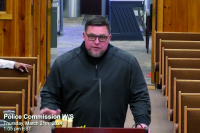Memories of the lost village of Needmore
Is there another region in the United States that has had more flourishing towns and villages disappear than the one along the Little Tennessee and Tuckasegee rivers in Swain and Macon counties? Almond, Japan, Judson, Bushnell, etc., in Swain went under when the Fontana reservoir was flooded in the 1940s. And there’s yet another “lost” town farther south up the Little Tennessee near the Macon County line that was sacrificed in the name of electric power but never actually went under water. Left high and dry to wither and die, the place is named Needmore.
Here’s that curious story as pieced together [25 years ago] from various printed sources and the memories of Dorothy Breedlove Burnett and her mother-in-law Esther DeHart Burnett Lawter, Needmore’s last postmasters.
Located several miles downstream from the ancient Cherokee settlements at Cowee in present Macon County, the Needmore area was first settled by non-Indians in the late 1820s. According to an article by Vinnie and Lambert Marr in the History of Swain County, the Brush Creek Baptist Church — the oldest church in the county and the mother church of the Tennessee River Baptist Association — was organized in December 1832 by members of the DeHart, Sherrill, Tabor, Truitt, Welch, and other families, as well as by “Hannah, a black woman.”
The first church building was located downstream from Needmore on the east side of the river. In the early 1900s, the church was rebuilt on a high ridge above the original site … 158 years after its founding.
Members living in communities on the far side of the river crossed over for services via a long swinging bridge spanning the Little Tennessee for services. The current state-maintained 275-foot bridge was built in the 1950s, crossing from the west bank over the tip of an island in the center of the river to the east bank. Two previous “ramshackled” footbridges built by members of the community below the island were washed away in floods.
The old ford was located in this area, and residents also used rowboats to ferry themselves and goods back and forth. It was always a divided community in the sense that homes and places of business were located on both banks.
Related Items
For a 1979 column in the Asheville Citizen-Times titled “Vanished Into Memory, Needmore Is No More,” John Parris interviewed the then-82-year-old Baptist preacher Theron Slagle, who had operated the quarry situated on the west bank that yielded the popular “Needmore stone” used for patios, hearths and chimneys.
Slagle recalled that “about 1880” Allison McHan got Needmore started by putting up a grist mill and general store so that it “wasn’t no time until a dozen or more families clustered into a settlement along the river. The thing that made Needmore was its situation on the river road running out of Macon County to the settlements below Bryson City ... When the railroad came west of Bryson City in 1884, the nearest shopping point for the folks of lower Macon County was the village of Almond, seven miles down river from Needmore ... It got to be a village of more than 200 people ... They were always saying they needed more of this and that. Every time the mail boy came by on his horse, somebody would say the folks need more of so and so until one day he hauled off and said, ‘You ought to name this place ‘need more.’ So when it come time the folks here on the river persuaded the government to give them their own post office, they suggested that it be called Needmore.”
According to Parris’ account and an article titled “Gaunt Abandoned Village Yields To Ravages of Time” (1956) in the Atlanta Journal by Bryson City author John Wikle, now deceased, the quarry, two grocery stores, and a grist mill were located on the west bank, with combined post office, grocery, and dry goods store on the other. Farmsteads were located all along the main river and back up creeks and branches with names like Painter, Charley, Monkey John, Hurricane, Licklog, and Rattlesnake. Traveling shows made regular stops, pitching their tents in the big field on the east side of the river.
Then, in 1912, the Nantahala Power Company — proposing a dam that would flood out the community — bought out the original owners. Many moved out or rented homes and property from “the river bed company,” the name they used for Nantahala Power. With the Great Depression of the 1930s, most of the renters “started drifting,” hoping for jobs “off yander” that usually never materialized. Needmore became a very quiet place.
Several old-time families were allowed to lease parcels of land on a yearly basis on both sides of the river. Dot Burnett’s son, Bill, who was raised on the river, leased a 37-acre allotment kept partially in corn but used primarily as a fishing camp.
Her mother-in-law, Esther Lawter, became Needmore’s postmaster in the late 1920s. Dot took over that position upon Lawter’s retirement in 1949. When the post office closed for good on June 30, 1951, her husband U.Z. Burnett — himself a longtime postal worker in Swain County until his death in 1983 — requested that she issue a money order in the amount of 1-cent to him as a keepsake.
The Burnetts continued living at Needmore until the late 1950s. Their home where the post office had been burned in 1962, but the site on the east side of the river a hundred yards down stream from the bridge is marked by boxwoods that Lawter planted long ago.
Both former postmasters resided in Bryson City into the 1990s. They recalled both the joys and hardships of life in remote Needmore. The families hoed corn right up to the post office doorstep.
Ironically, although there was a telephone line, there was no electricity in an area owned by a power company. Much of Needmore’s commerce was conducted on a barter system: eggs, chickens, corn, etc., for store goods or services. They kept goats, sheep, and cattle on the big island the footbridge crosses. U.Z. learned to “unsull” a balky steer by submerging its head underwater. In 1940, when a flood swept the river, the family’s billy goat was last sighted far downstream.
“It was pretty rough raising 3 kids on $10 a month,” said Lawter. “But, oh yes, I’d just love to live out there at Needmore yet.”
“Not me,” said Burnett, who earned $32 a month as postmaster. “I married U.Z. to get out of Needmore and by gosh he up and took me right back down there.”
But her eyes sparkled as she recalled how she and U.Z. floated the river “all day long” in tubes fishing for catfish; or how all the neighbors — after picking up their mail — came in to see the community’s new member when her daughter Judy was born at the Needmore post office.
(Author’s note: This account of the “lost” village of Needmore is based on interviews, etc., conducted in the early 1990s. I am updating it here to supplement the excellent Internet page devoted to Needmore recently posted by the Franklin-based “Stay & Play in the Smokies”: www.stayandplayinthesmokies.com/vendor/needmore-road-along-the-little-tennessee-river)
George Ellison wrote the biographical introductions for the reissues of two Appalachian classics: Horace Kephart’s Our Southern Highlanders and James Mooney’s History, Myths, and Sacred Formulas of the Cherokees. In June 2005, a selection of his Back Then columns was published by The History Press in Charleston as Mountain Passages: Natural and Cultural History of Western North Carolina and the Great Smoky Mountains. Readers can contact him at P.O. Box 1262, Bryson City, N.C., 28713, or at This email address is being protected from spambots. You need JavaScript enabled to view it..









